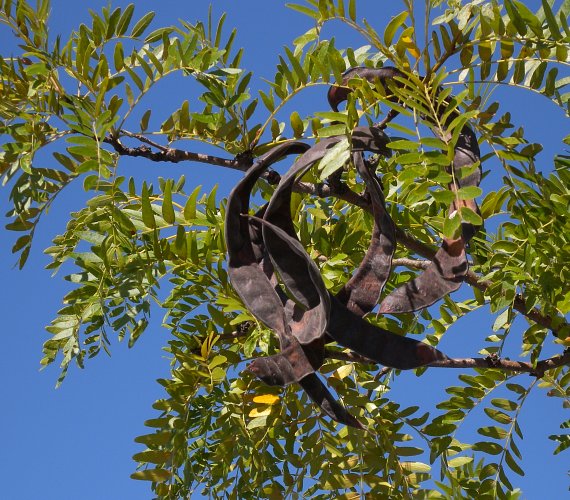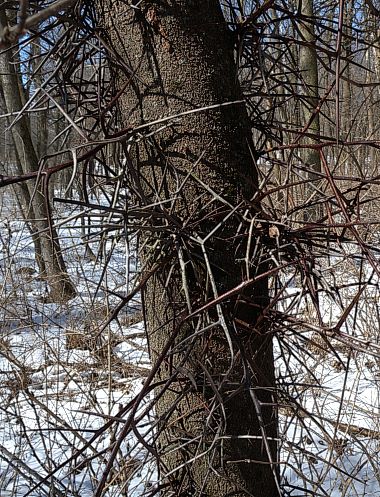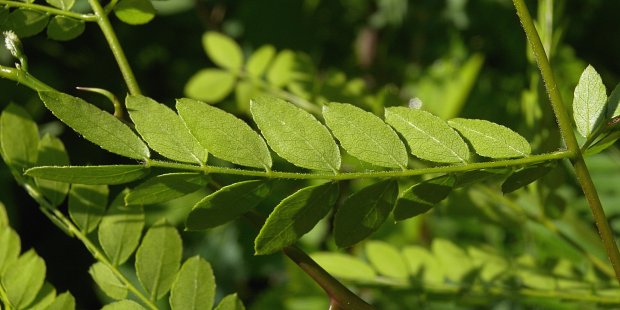
The small greenish yellow flowers are produced in racemes about 2-5" long; they are usually male (staminate) or female (pistillate), although sometimes perfect (both staminate & pistillate). Individual male flowers have a calyx with 5 lobes, 4-5 petals, and 3-10 stamens, while individual female flowers have a calyx with 5 lobes and a pistil with a single style. Individual perfect flowers have both a pistil and several stamens. The blooming period occurs from late spring to early summer for about 2 weeks. The flowers have a sweet fragrance. Fertile female flowers are replaced by flattened seedpods that become 6-14" long and 1-1½" across at maturity. Mature seedpods are dark brown, hairless, and often hooked or spirally twisted. Each seedpod contains several large seeds that are reniform in shape and about 1/3" (8 mm.) long; they have hard seed coats. The seeds are embedded in a thick sweet pulp. The seedpods fall to the ground unopened during the late fall or winter. The woody root system has a taproot and abundant lateral roots that are widely spreading and deep. The deciduous leaflets turn yellow during the autumn.

Cultivation: This adaptable tree prefers full to partial sunlight and moist to dry-mesic conditions. It will flourish in almost any type of soil (pH range 6.0-8.0) if it is not too acidic. Both temporary flooding and hot dry weather are tolerated. The root system doesn't fix nitrogen in the soil. New trees can be propagated by seeds or vegetatively by cuttings. Growth and development is fairly fast; young trees can produce seedpods in as little as 10 years. Longevity of healthy trees is typically 100-150 years. One of the advantages of Honey Locust as a landscape tree is the light shade that is cast by its open crown; this allows the survival of turfgrass and other plants.
Range & Habitat: The native Honey Locust has been found in almost every county of Illinois; it is common. Habitats include upland woodlands, bottomland woodlands, woodland openings, woodland
Faunal Associations: The seemingly inconspicuous flowers are cross-pollinated by honeybees, bumblebees, Halictid bees (Lasioglossum spp., Agapostemon sericea), Andrenine bees (Andrena spp.), Syrphid flies, and other flies. The bees suck on the nectar or collect pollen, while the flies suck nectar or feed on pollen (Robertson, 1929). Many kinds of insects feed on various parts of Honey Locust as a source of food. These insects include the larvae of the Honey Locust Borer (Agrilus difficilis) and other metallic wood-boring beetles, leaf beetles, larvae of gall flies, the Honey Locust Plant Bug (Blepharidopterus chlorionis) and other plant bugs, the Honey Locust Leafhopper (Macropsis fumipennis) and other leafhoppers (Erythridula spp.), the Honey Locust Scurfy Scale (Chionaspis gleditsiae) and other armored scales, and the larvae of many moths, including Riley's Lappet Moth (Heteropacha rileyana), The Betrothed (Catocala innubens), Little Underwing (Catocala minuta), Moon-lined Moth (Spiloloma lunilinea), Honey Locust Moth (Sphingicampa bicolor), and Bisected Honey Locust Moth (Sphingicampa bisecta). The Honey Locust Spider Mite (Platytetranychus multidigituli) can be found on the leaflet undersides of this tree (MacRae, 1991; Clark et al., 2004; Cranshaw, 2004; Stireman et al., 2010; Knight, 1941; Wheeler et al., 1983; Dmitriev & Dietrich, accessed 2010; ScaleNet, accessed 2014; Covell, 1984/2005). See the Insect Table for a more complete list of these insect feeders. For vertebrate animals, the seedpods (primarily the honey-like gel) are eaten by deer, squirrels, rabbits, wild hogs, opossums, raccoons, and cattle (Shadow, USDA, accessed 2024). At one time, the seedpods were a source of food for the extinct American Mastodon and the extinct Carolina Parakeet (Snyder, 2004). Many of these animals are unable to digest the large seeds of Honey Locust inside the pods, so they help to spread them to new areas. The tender shoots of Honey Locust during the spring and the bark of young trees during winter are a source of food to deer, cattle, and sheep, and dense stands of young thorny trees can provide excellent cover for many kinds of wildlife (Shadow, USDA, accessed 2024). Honey Locust trees are also used as roost sites for some birds and bats, such as the Eastern Screech Owl, Eastern Red Bat, and Evening Bat (Belthoff & Ritchison, 1990; Mager & Nelson, 2001; MuÍnzer, 2008).
Photographic Location: Busey Woods and other locations in Urbana, Illinois.

Comments: Wild trees are often formidably armed by thorns; it is possible that this functioned as a defense against the American Mastodon and other large megafauna of the last ice age. Today, these thorns discourage squirrels, opossums, raccoons, and humans from climbing this tree. The only other tree that Honey Locust can be confused with in the Midwest is Black Locust (Robinia pseudoacacia). Black Locust has slightly larger leaflets, fewer thorns, shorter seedpods, and more showy white flowers. These flowers have a pea-like floral structure that is typical of species in the Bean family (Fabaceae). The greenish yellow flowers of Honey Locust, in contrast, have a more conventional floral structure.